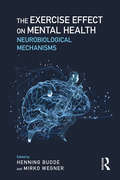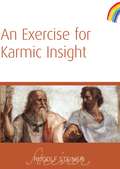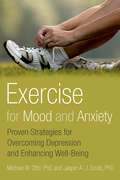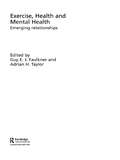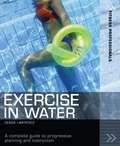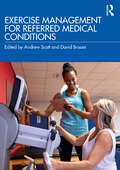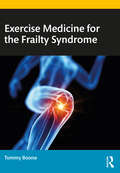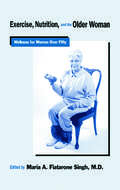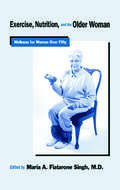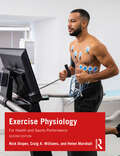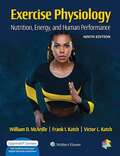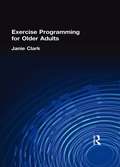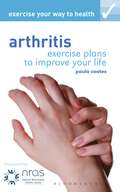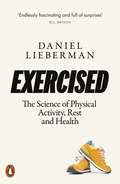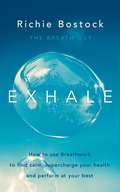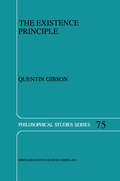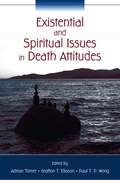- Table View
- List View
The Exercise Effect on Mental Health: Neurobiological Mechanisms
by Henning Budde Mirko WegnerThe Exercise Effect on Mental Health contains the most recent and thorough overview of the links between exercise and mental health, and the underlying mechanisms of the brain. The text will enhance interested clinicians’ and researchers’ understanding of the neurobiological effect of exercise on mental health. Editors Budde and Wegner have compiled a comprehensive review of the ways in which physical activity impacts the neurobiological mechanisms of the most common psychological and psychiatric disorders, including depression, anxiety, bipolar disorder, and schizophrenia. This text presents a rigorously evidence-based case for exercise as an inexpensive, time-saving, and highly effective treatment for those suffering from mental illness and distress.
The Exercise Effect on Mental Health: Neurobiological Mechanisms
by Henning Budde Mirko WegnerThe Exercise Effect on Mental Health contains the most recent and thorough overview of the links between exercise and mental health, and the underlying mechanisms of the brain. The text will enhance interested clinicians’ and researchers’ understanding of the neurobiological effect of exercise on mental health. Editors Budde and Wegner have compiled a comprehensive review of the ways in which physical activity impacts the neurobiological mechanisms of the most common psychological and psychiatric disorders, including depression, anxiety, bipolar disorder, and schizophrenia. This text presents a rigorously evidence-based case for exercise as an inexpensive, time-saving, and highly effective treatment for those suffering from mental illness and distress.
An Exercise for Karmic Insight
by Rudolf SteinerThere is the possibility of a comparatively quick maturing of insight into karmic relationships if, for a considerable time, we try patiently, and with inner energy, to picture with greater and greater consciousness an experience which would otherwise simply take its course, without being properly grasped, and fade away in the course of life...In this unique lecture, Rudolf Steiner presents a practical exercise for gaining insight into karma. He draws our attention to the ordinary events of life, encouraging us to take an image of a single event and meditate on it. He describes the method in great detail, and explains how, over several days and nights, the image becomes incorporated into our various spiritual bodies. Eventually, this image reaches our physical body in a transformed state, leading to a perception of a previous earth life and the cause of the event first pictured in meditation...
Exercise for Mood and Anxiety: Proven Strategies for Overcoming Depression and Enhancing Well-Being
by Michael Otto Jasper A.J. SmitsExercise has long been touted anecdotally as an effective tool for mood improvement, but only recently has rigorous science caught up with these claims. There is now overwhelming evidence that regular exercise can help relieve low mood-from feelings of stress and anxiety to full depressive episodes. With Exercise for Mood and Anxiety, Michael Otto and Jasper Smits, well-known authorities on cognitive behavioral therapy, take their empirically-based mood regulation strategy from the clinic to the general public. Written for those with diagnosed mood disorders as well as those who simply need a new strategy for managing the low mood and stress that is an everyday part of life, this book provides readers with step-by-step guidance on how to start and maintain an exercise program geared towards improving mood, with a particular emphasis on understanding the relationship between mood and motivation. Readers learn to attend carefully to mood states prior to and following physical activity in order to leverage the full benefits of exercise, and that the trick to maintaining an exercise program is not in applying more effort, but in arranging one's environment so that less effort is needed. As a result readers not only acquire effective strategies for adopting a successful program, but are introduced to a broader philosophy for enhancing overall well-being. Providing patient vignettes, rich examples, and extensive step-by-step guidance on overcoming the obstacles that prevent adoption of regular exercise for mood, Exercise for Mood and Anxiety is a unique translation of scientific principles of clinical and social psychology into an action-based strategy for mood change.
Exercise for Mood and Anxiety: Proven Strategies for Overcoming Depression and Enhancing Well-Being
by Michael Otto Jasper A.J. SmitsExercise has long been touted anecdotally as an effective tool for mood improvement, but only recently has rigorous science caught up with these claims. There is now overwhelming evidence that regular exercise can help relieve low mood-from feelings of stress and anxiety to full depressive episodes. With Exercise for Mood and Anxiety, Michael Otto and Jasper Smits, well-known authorities on cognitive behavioral therapy, take their empirically-based mood regulation strategy from the clinic to the general public. Written for those with diagnosed mood disorders as well as those who simply need a new strategy for managing the low mood and stress that is an everyday part of life, this book provides readers with step-by-step guidance on how to start and maintain an exercise program geared towards improving mood, with a particular emphasis on understanding the relationship between mood and motivation. Readers learn to attend carefully to mood states prior to and following physical activity in order to leverage the full benefits of exercise, and that the trick to maintaining an exercise program is not in applying more effort, but in arranging one's environment so that less effort is needed. As a result readers not only acquire effective strategies for adopting a successful program, but are introduced to a broader philosophy for enhancing overall well-being. Providing patient vignettes, rich examples, and extensive step-by-step guidance on overcoming the obstacles that prevent adoption of regular exercise for mood, Exercise for Mood and Anxiety is a unique translation of scientific principles of clinical and social psychology into an action-based strategy for mood change.
Exercise, Health and Mental Health: Emerging Relationships
by Guy E.J. Faulkner Adrian H. TaylorExercise, Health and Mental Health provides an introduction to this emerging field and a platform for future research and practice. Written by internationally acclaimed exercise, health and medical scientists, it is the first systematic review of the evidence for the potential role of exercise in: treating and managing mental health problems including dementia, schizophrenia, drug and alcohol dependence coping with chronic clinical conditions including cancer, heart disease and HIV/AIDS enhancing well-being in the general population – by improving sleep, assisting in smoking cessation, and as a way of addressing broader social issues such as anti-social behaviour. Adopting a consistent and accessible format, the research findings for each topic are clearly summarized and critically examined for their implications.
Exercise, Health and Mental Health: Emerging Relationships
by Guy E.J. Faulkner Adrian H. TaylorExercise, Health and Mental Health provides an introduction to this emerging field and a platform for future research and practice. Written by internationally acclaimed exercise, health and medical scientists, it is the first systematic review of the evidence for the potential role of exercise in: treating and managing mental health problems including dementia, schizophrenia, drug and alcohol dependence coping with chronic clinical conditions including cancer, heart disease and HIV/AIDS enhancing well-being in the general population – by improving sleep, assisting in smoking cessation, and as a way of addressing broader social issues such as anti-social behaviour. Adopting a consistent and accessible format, the research findings for each topic are clearly summarized and critically examined for their implications.
Exercise in Water: A complete guide to progressive planning and instruction (Fitness Professionals)
by Debbie LawrenceFitness Professionals: Exercise in Water (3rd edition) is a practical handbook for theregular exerciser who wishes to know more about the enormous benefitsof training in water, and the fitness professional who seeks a thoroughgrounding in Level 2 and 3 knowledge.This new edition will completely update the book, taking into accountlatest best practice and explicitly linking the contents to thenational standards to which all gym instructors and personal trainersare assessed. Exercise in Water is one of the core modules of the Level 2 gyminstructors syllabus, and a new Level 3 qualification has been added inJanuary 2008. This edition will cover all this knowledge, usingrevision notes and tests as useful tools for the readers' study.Fitness Professionals: Exercise in Water therefore aims to become thereference on this discipline for everyone involved in the health andfitness industry.
Exercise Management for Referred Medical Conditions
by Andrew Scott David BroomExercise referral describes the process of consultation, planning and instructing physical activity programmes and applying appropriate behaviour change strategies for clients presenting a range of low- to medium-risk medical conditions. Exercise Management for Referred Medical Conditions is the first book to integrate exercise prescription with the development of healthy behaviours and the promotion of physical activity and well-being and provides students with an evidence-based, applied guide to becoming effective exercise referral practitioners. The book draws upon the latest research and recommends best practices for creating referral pathways, providing exercise programmes and engaging clients in health lifestyles. Covering the pathology, medical management, role of exercise and recommendations for programming in each case, it discusses a range of conditions, including: Obesity and type I and II diabetes Hypertension and dyslipidaemia Asthma Low back pain, osteoarthritis and joint replacement, rheumatoid arthritis, and osteoporosis Depression, anxiety and stress disorders Consistently organised and laden with pedagogical features, including learning objectives, key terms, case studies, future developments and chapter summaries, no other book offers such a clear, holistic model for exercise referral. This is a vital resource for any student undertaking vocational courses in exercise referral and an important reference for exercise scientists, physical therapists, fitness professionals or local policy-makers interested in the use of physical activity in healthcare.
Exercise Management for Referred Medical Conditions
by Andrew Scott David BroomExercise referral describes the process of consultation, planning and instructing physical activity programmes and applying appropriate behaviour change strategies for clients presenting a range of low- to medium-risk medical conditions. Exercise Management for Referred Medical Conditions is the first book to integrate exercise prescription with the development of healthy behaviours and the promotion of physical activity and well-being and provides students with an evidence-based, applied guide to becoming effective exercise referral practitioners. The book draws upon the latest research and recommends best practices for creating referral pathways, providing exercise programmes and engaging clients in health lifestyles. Covering the pathology, medical management, role of exercise and recommendations for programming in each case, it discusses a range of conditions, including: Obesity and type I and II diabetes Hypertension and dyslipidaemia Asthma Low back pain, osteoarthritis and joint replacement, rheumatoid arthritis, and osteoporosis Depression, anxiety and stress disorders Consistently organised and laden with pedagogical features, including learning objectives, key terms, case studies, future developments and chapter summaries, no other book offers such a clear, holistic model for exercise referral. This is a vital resource for any student undertaking vocational courses in exercise referral and an important reference for exercise scientists, physical therapists, fitness professionals or local policy-makers interested in the use of physical activity in healthcare.
Exercise Medicine for the Frailty Syndrome
by Tommy BooneFrailty is a clinical syndrome caused by multiple chronic conditions that makes it difficult to maintain homeostasis. In part, it is the result of the body’s inability to regulate normal inflammatory responses that lead to muscle loss, decrease in strength, and independence. Regular exercise helps to optimize physiological performance. It is a profound influence, especially in the presence of physical inactivity, where the lack of exercise leads to poor health and decreased longevity. Unfortunately, a high percentage of Americans fail to engage in daily exercise with the older population becoming increasingly frail, which is a syndrome characterized by declines in musculoskeletal and physiologic reserve and function. It has been documented that exercise is medicine and can be better than the effects induced by drugs. Exercise physiologists are healthcare professionals. They are key professionals in developing and applying an exercise medicine prescription for frail adults. Exercise Medicine for the Frailty Syndrome speaks to the benefits of exercise medicine as the best therapy to prevent or reverse the age-related muscle loss and functional deficits that are predictive of an increase in falls, hospitalization, institutionalization, and mortality. This book is a proactive step to help increase the functional independence of older frail adults. It highlights Board Certification by the American Society of Exercise Physiologists as the professional qualification to improve society’s understanding of the biological treatment and complexity of the frailty syndrome and is key reading for Exercise Physiologists.
Exercise Medicine for the Frailty Syndrome
by Tommy BooneFrailty is a clinical syndrome caused by multiple chronic conditions that makes it difficult to maintain homeostasis. In part, it is the result of the body’s inability to regulate normal inflammatory responses that lead to muscle loss, decrease in strength, and independence. Regular exercise helps to optimize physiological performance. It is a profound influence, especially in the presence of physical inactivity, where the lack of exercise leads to poor health and decreased longevity. Unfortunately, a high percentage of Americans fail to engage in daily exercise with the older population becoming increasingly frail, which is a syndrome characterized by declines in musculoskeletal and physiologic reserve and function. It has been documented that exercise is medicine and can be better than the effects induced by drugs. Exercise physiologists are healthcare professionals. They are key professionals in developing and applying an exercise medicine prescription for frail adults. Exercise Medicine for the Frailty Syndrome speaks to the benefits of exercise medicine as the best therapy to prevent or reverse the age-related muscle loss and functional deficits that are predictive of an increase in falls, hospitalization, institutionalization, and mortality. This book is a proactive step to help increase the functional independence of older frail adults. It highlights Board Certification by the American Society of Exercise Physiologists as the professional qualification to improve society’s understanding of the biological treatment and complexity of the frailty syndrome and is key reading for Exercise Physiologists.
Exercise, Nutrition and the Older Woman: Wellness for Women Over Fifty
by Maria A. Fiatarone SinghExercise, Nutrition and the Older Woman: Wellness for Women Over Fifty is a comprehensive guide to the major wellness issues for women over fifty. The author is a physician who explores diet, exercise and lifestyle choices from a medical perspective. The book assists in the design and implementation of programs to optimize good health and quality o
Exercise, Nutrition and the Older Woman: Wellness for Women Over Fifty
by Maria A. Fiatarone SinghExercise, Nutrition and the Older Woman: Wellness for Women Over Fifty is a comprehensive guide to the major wellness issues for women over fifty. The author is a physician who explores diet, exercise and lifestyle choices from a medical perspective. The book assists in the design and implementation of programs to optimize good health and quality o
Exercise Physiology: for Health and Sports Performance
by Nick Draper Craig Williams Helen MarshallThis second edition of Exercise Physiology: For Health and Sports Performance brings together all the essential human anatomy and applied physiology that students of exercise science, physical education, and sports coaching will need to know.Written in a friendly, accessible style, and containing a wide range of features to help develop understanding, this book provides a complete one-stop shop for exercise physiology broken down into three fundamental parts: foundations of exercise physiology, applied exercise physiology, and the new Part 3, exercise prescription.With Parts 1 and 2 examining the theory, testing, and practical applications of exercise physiology, the new Part 3 reflects the changes in the field by increasing focus on physical activity and diverse populations and helps provides a more complete course text for any exercise physiology course at universities around the world.This newly revised book is key reading for undergraduate and postgraduate students in the fields of exercise physiology, sports performance, sports therapy, fitness and personal training, and other related sport science courses.
Exercise Physiology: for Health and Sports Performance
by Nick Draper Craig Williams Helen MarshallThis second edition of Exercise Physiology: For Health and Sports Performance brings together all the essential human anatomy and applied physiology that students of exercise science, physical education, and sports coaching will need to know.Written in a friendly, accessible style, and containing a wide range of features to help develop understanding, this book provides a complete one-stop shop for exercise physiology broken down into three fundamental parts: foundations of exercise physiology, applied exercise physiology, and the new Part 3, exercise prescription.With Parts 1 and 2 examining the theory, testing, and practical applications of exercise physiology, the new Part 3 reflects the changes in the field by increasing focus on physical activity and diverse populations and helps provides a more complete course text for any exercise physiology course at universities around the world.This newly revised book is key reading for undergraduate and postgraduate students in the fields of exercise physiology, sports performance, sports therapy, fitness and personal training, and other related sport science courses.
Exercise Physiology 9e Revis: (pdf) (Lippincott Connect Ser.)
by McardleWith a legacy spanning more than 40 years, Exercise Physiology: Nutrition, Energy, and Human Performance has helped nearly half a million students and exercise science practitioners build a solid foundation in the scientific principles underlying modern exercise physiology. This widely praised, trendsetting text presents a research-centric approach in a vibrant, engaging design to make complex topics accessible and deliver a comprehensive understanding of how nutrition, energy transfer, and exercise training affect human performance. The extensively updated 9th Edition reflects the latest advances in the field as well as a rich contextual perspective to ensure readiness for today’s clinical challenges.
Exercise Programming for Older Adults
by Janie ClarkThe exercise programming guidelines provided in this book focus on functional fitness training and safety and demonstrate how physical activities supervised by activities personnel can strongly benefit participants’quality of life. Exercise Programming for Older Adults guarantees that exercise programming attains a balance between the three major physical components--aerobic, strength, and flexibility training--and that each component is properly administered. The techniques and applications described are geared toward those with prevalent conditions of aging such as arthritis, osteoporosis, joint replacement, cardiovascular disease, stroke, and chronic obstructive pulmonary disease.This essential handbook arms the reader with a multidisciplinary approach to exercise management for elderly populations. The chapter authors are experts from the fields of fitness instruction, nursing, physical therapy, medicine, research, and exercise physiology. As they address the theory and practice of providing sound exercise programming, specific exercises are described and illustrated, with emphasis on functional fitness outcomes, safety precautions, fall prevention, and practical adaptations for low-fit and physically limited participants. Chapter discussions include:aerobic exercisestrength trainingflexibility trainingthe administration of mild posture and breathing exercises for debilitated individuals with poor prognosespositioning and transfer techniques essential for optimal activities management of neurologically impaired patientswarm water exercise programs designed for persons with low tolerance of conventional training methodsExercise Programming for Older Adults serves as a vital resource for activity coordinators in long-term care settings and for group fitness instructors and personal trainers who serve older adult and frail elderly clientele. Readers will discover alternative techniques and applications for maximizing the physical and mental therapeutic benefits of exercise and developing the functional fitness of even the most physically challenged participants.
Exercise Programming for Older Adults
by Janie ClarkThe exercise programming guidelines provided in this book focus on functional fitness training and safety and demonstrate how physical activities supervised by activities personnel can strongly benefit participants’quality of life. Exercise Programming for Older Adults guarantees that exercise programming attains a balance between the three major physical components--aerobic, strength, and flexibility training--and that each component is properly administered. The techniques and applications described are geared toward those with prevalent conditions of aging such as arthritis, osteoporosis, joint replacement, cardiovascular disease, stroke, and chronic obstructive pulmonary disease.This essential handbook arms the reader with a multidisciplinary approach to exercise management for elderly populations. The chapter authors are experts from the fields of fitness instruction, nursing, physical therapy, medicine, research, and exercise physiology. As they address the theory and practice of providing sound exercise programming, specific exercises are described and illustrated, with emphasis on functional fitness outcomes, safety precautions, fall prevention, and practical adaptations for low-fit and physically limited participants. Chapter discussions include:aerobic exercisestrength trainingflexibility trainingthe administration of mild posture and breathing exercises for debilitated individuals with poor prognosespositioning and transfer techniques essential for optimal activities management of neurologically impaired patientswarm water exercise programs designed for persons with low tolerance of conventional training methodsExercise Programming for Older Adults serves as a vital resource for activity coordinators in long-term care settings and for group fitness instructors and personal trainers who serve older adult and frail elderly clientele. Readers will discover alternative techniques and applications for maximizing the physical and mental therapeutic benefits of exercise and developing the functional fitness of even the most physically challenged participants.
Exercise your way to health: Exercise plans to improve your life (Exercise Your Way to Health)
by Paula CoatesMore than 10 million adults consult their GP each year with arthritis and related conditions. Exercise your way to health: Arthritis will show you how to include a simple fitness programme in your life, while considering the specific challenges raised by arthritis. This simple to follow guide helps you to manage your arthritis by giving you an understanding of your diagnosis and how it impacts on your body and health. Arthritis can be painful but with the right lifestyle choices and exercise you can reduce your pain. There is no reason why arthritis should stop you living a full and active life. You will start to see improvements within 6 weeks, when you can re-test your fitness level. This will be all the motivation you need to keep your new lifestyle on track to a happier and healthier you!
Exercised: The Science of Physical Activity, Rest and Health
by Daniel Lieberman'Endlessly fascinating and full of surprises. Easily one of my books of the year' BILL BRYSONThe myth-busting science behind our modern attitudes to exercise: what our bodies really need, why it matters, and its effects on health and wellbeing. In industrialized nations, our sedentary lifestyles have contributed to skyrocketing rates of obesity and diseases like diabetes. A key remedy, we are told, is exercise - voluntary physical activity for the sake of health. However, most of us struggle to stay fit, and our attitudes to exercise are plagued by misconceptions, finger-pointing and anxiety.But, as Daniel Lieberman shows in Exercised, the first book of its kind by a leading scientific expert, we never evolved to exercise. We are hardwired for moderate exertion throughout each day, not triathlons or treadmills. Drawing on over a decade of high-level scientific research and eye-opening insights from evolutionary biology and anthropology, Lieberman explains precisely how exercise can promote health; debunks persistent myths about sitting, speed, strength and endurance; and points the way towards more enjoyable and physically active living in the modern world.'Myth-busting, illuminating, brilliant - Lieberman will completely change the way you think about your body' Professor ALICE ROBERTS, presenter of Our Incredible Human Journey
Exhale: How to Use Breathwork to Find Calm, Supercharge Your Health and Perform at Your Best
by Richie BostockMore energy, less stress, better sleep, happier lives. Isn't that what we all wish we had more of? Well, the solution is, quite literally, under your nose: your breath. From leading Breathwork practitioner, Richie Bostock, comes Exhale - a guide to learning the transformative power of breathing to help you lead a happier, healthier life.Exhale will help you master your physical, mental and emotional state in the comfort of your own home. Whether you're looking to reduce stress, improve creativity, tackle back pain or treat chronic ailments, conscious breathing has benefits for everyone.With over 40 exercises, experience the life-changing effects of Breathwork and cultivate your own breathing toolkit. With techniques inspired by traditional Sufi meditation and practices implemented by the Navy SEALS, Richie's Breathwork plan will help you find the solution to life's everyday challenges, in as little as ten minutes a day.Greater health and happiness is just a few breaths away.
The Existence Principle (Philosophical Studies Series #75)
by Q.B. GibsonWhen we ask whether something exists, we expect a yes or no answer, not a further query about what kind of existence, how much of it, whether we mean existence for you or existence for me, or whether we are asking about some property which it might have. In this book, this simple requirement is defended and pursued into its various and sometimes surprising implications. In the course of this pursuit, such questions arise as `Do appearances exist?' `Do unknowable things exist?' `Do past and future exist?' `Does God necessarily exist?' This novel and non-technical approach to important philosophical questions will be of interest to senior students of philosophy and, indeed, to all general readers with philosophical interests.
Existential and Spiritual Issues in Death Attitudes
by Adrian Tomer • Grafton T. Eliason • Paul T. P. WongExistential and Spiritual Issues in Death Attitudes provides: an in-depth examination of death attitudes, existentialism, and spirituality and their relationships; a review of the major theoretical models; clinical applications of these models to issues such as infertility, bereavement, anxiety, and suicide; and an introduction to meaning managemen
Existential and Spiritual Issues in Death Attitudes
by Adrian Tomer Grafton T. Eliason Paul T. P. WongExistential and Spiritual Issues in Death Attitudes provides: an in-depth examination of death attitudes, existentialism, and spirituality and their relationships; a review of the major theoretical models; clinical applications of these models to issues such as infertility, bereavement, anxiety, and suicide; and an introduction to meaning managemen
